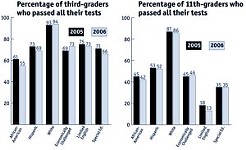Taking the TAKS Is Hard … Understanding the Results Is Harder
Austin ISD scores better -- we think
By Rachel Proctor May, Fri., March 4, 2005
"It's really hard to explain, especially because we have two ratings system in this state," said Julie Lyons, AISD's director of state and federal accountability. "It is so complex, and people don't really understand it."
It all has to do with the way school progress is measured under the federal accountability system, which analyzes the results of annual Texas Assessment of Knowledge and Skills tests in an entirely different way than the state does. Under NCLB, progress means "adequate yearly progress," which measures target passing rates for tested subjects, graduation rates, and – importantly – test participation. Schools can either "meet AYP" or "miss AYP"; failing to meet AYP in any area for two years in a row is what gets a school labeled "needs improvement."
However, NCLB also divides schools into separate subgroups according to ethnicity, limited English proficiency, and special education. Each subgroup within a school must meet AYP; each must also have 95% participation. This creates a situation not unlike the old rhyme where for want of a nail, the kingdom was lost.
Imagine a 10th-grade class of 1,000 students, 50 of whom are Hispanic. If on test day, just a handful of Hispanic students are absent, then the school would "miss AYP" for math participation of Hispanic students. If it happens two years in a row, the whole school would "need improvement," which means its students are automatically eligible for transfer to schools with better test scores, with the district providing transportation. (As NCLB is phased in, sanctions against schools that need improvement may be even more dire.)
As a real-life example, LBJ High got on the "needs improvement" list because of two years of missing AYP in math participation. However, AISD examined the data and found a clerical error that accounted for a single extra student taking the test. That brought LBJ's math participation rate from 94.3% to 94.7%, rounding brought it to 95%, and the entire school was moved off the needs improvement list. In other words, getting kids to show up is sometimes half the battle.
"You've got to get the children to take the test, that's the message," said AISD Superintendent Pat Forgione. "We got the message."
The other half of the battle is dealing with special ed students. For years, the state accountability system has allowed any documented special education student to be tested under a "state-developed alternative assessment," or SDAA. But under NCLB, no more than 1% of students are allowed to take the alternative test, even though about 10% of Texas students are special ed.
Because of confusion over the two systems, the Texas Education Agency this year allowed school districts to appeal poor ratings that resulted from exceeding the 1% cap, if they could demonstrate that all the students tested as special ed met the SDAA guidelines. It was these special education and participation appeals which resulted in LBJ High, Fulmore Middle, and Burnet Middle being moved from the "needs improvement" list, and 20 schools and the district meeting AYP when it was previously ruled they had missed it.
While the improved ratings please AISD, no one is exactly overjoyed – next year's TAKS results, complete with the two competing sets of ratings, will be ready for quibbling over once again in August. And in the meantime, there's all the work that needs to be done at schools whose poor test scores no clerical error can explain away.
Got something to say on the subject? Send a letter to the editor.








